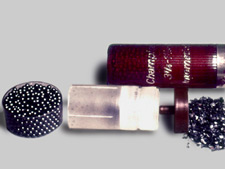Home | Glossary | Resources | Help | Contact Us | Course Map
Archival Notice
This is an archive page that is no longer being updated. It may contain outdated information and links may no longer function as originally intended.
Fired Shotshell Components
The construction and components of shotshells are described in depth in Module 5.
Shotshells may be comprised of a number of components:
- Card (paper) or fiber disks
- Plastic wadding components
- Lead, steel, bismuth, or tungsten alloy shot pellets
- Shotgun slugs
- Shot buffer materials (granular plastic particulate)
Wadding Material
The examination of shot wads frequently revolves around a comparison of remaining observable physical characteristics to an unfired laboratory reference standard.
By examining wadding materials, the examiner may be able to determine
- the gauge of the shotgun,
- the manufacturer or marketer,
- a range of possible shot sizes based on impressions in the wad,
- individual characteristics (in some cases).
Paper and fiber wadding materials are similar in appearance across brands.
Wadding materials may include the following:
- Card wad
- Shot collar
- Over-shot wad or top wad
- Under-shot wad
- Filler wad
- Over-powder wad
- Cup wad
Although older fiber and paper wads are no longer widely used, their examination presents several difficulties because they
- tend to absorb body fluids,
- swell beyond their original dimensions,
- often dry without retaining original dimensions,
- are more easily damaged than plastic wadding materials.
Plastic wads are predominately used today.
Types of plastic wadding materials include
- shot protector wad,
- shot collar,
- combination wad.
Examiners should be aware that combinations of plastic and card and fiber wadding materials have been used and continue to be found; these wadding types are not mutually exclusive.
Additional Online Courses
- What Every First Responding Officer Should Know About DNA Evidence
- Collecting DNA Evidence at Property Crime Scenes
- DNA – A Prosecutor’s Practice Notebook
- Crime Scene and DNA Basics
- Laboratory Safety Programs
- DNA Amplification
- Population Genetics and Statistics
- Non-STR DNA Markers: SNPs, Y-STRs, LCN and mtDNA
- Firearms Examiner Training
- Forensic DNA Education for Law Enforcement Decisionmakers
- What Every Investigator and Evidence Technician Should Know About DNA Evidence
- Principles of Forensic DNA for Officers of the Court
- Law 101: Legal Guide for the Forensic Expert
- Laboratory Orientation and Testing of Body Fluids and Tissues
- DNA Extraction and Quantitation
- STR Data Analysis and Interpretation
- Communication Skills, Report Writing, and Courtroom Testimony
- Español for Law Enforcement
- Amplified DNA Product Separation for Forensic Analysts


